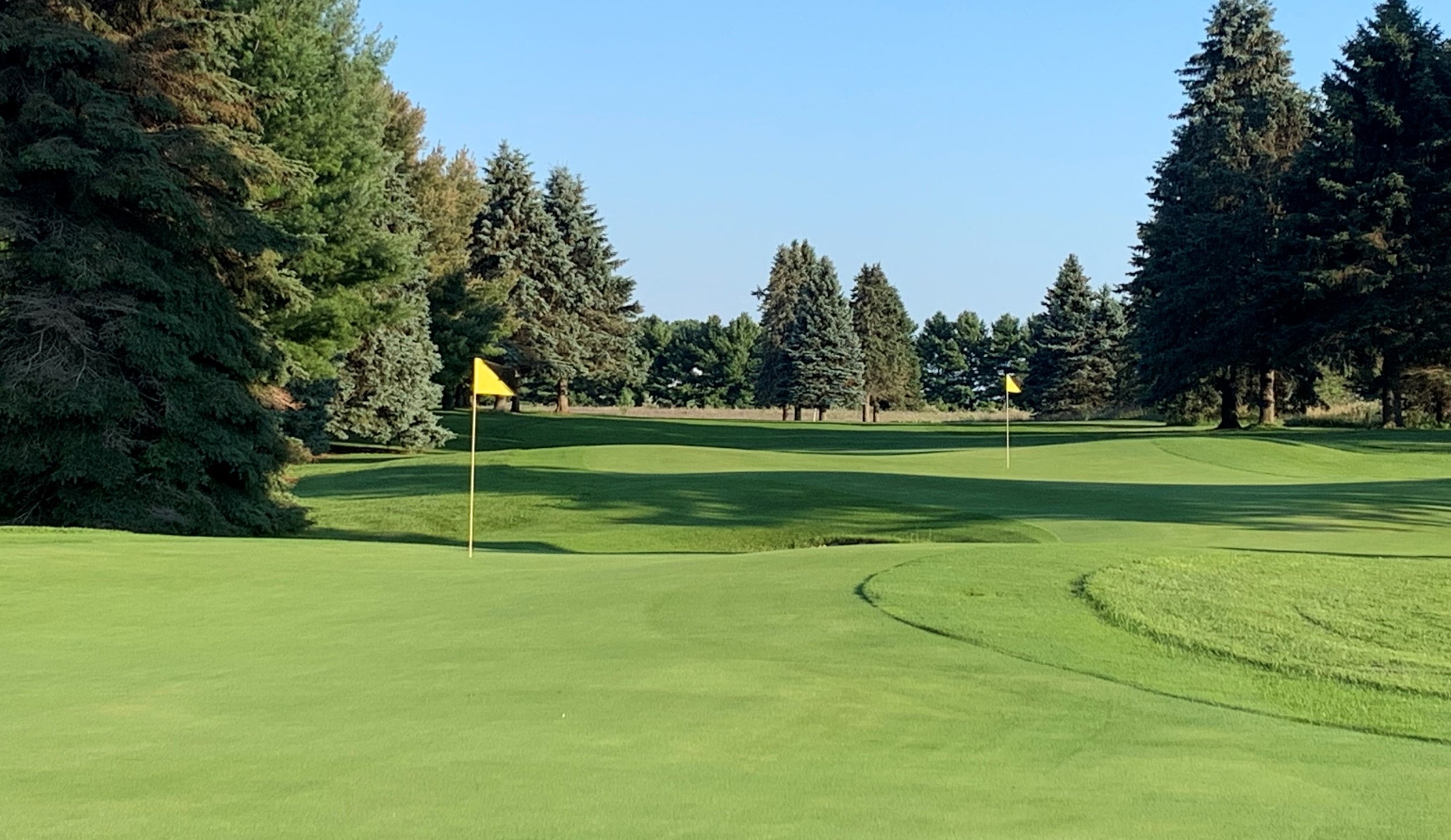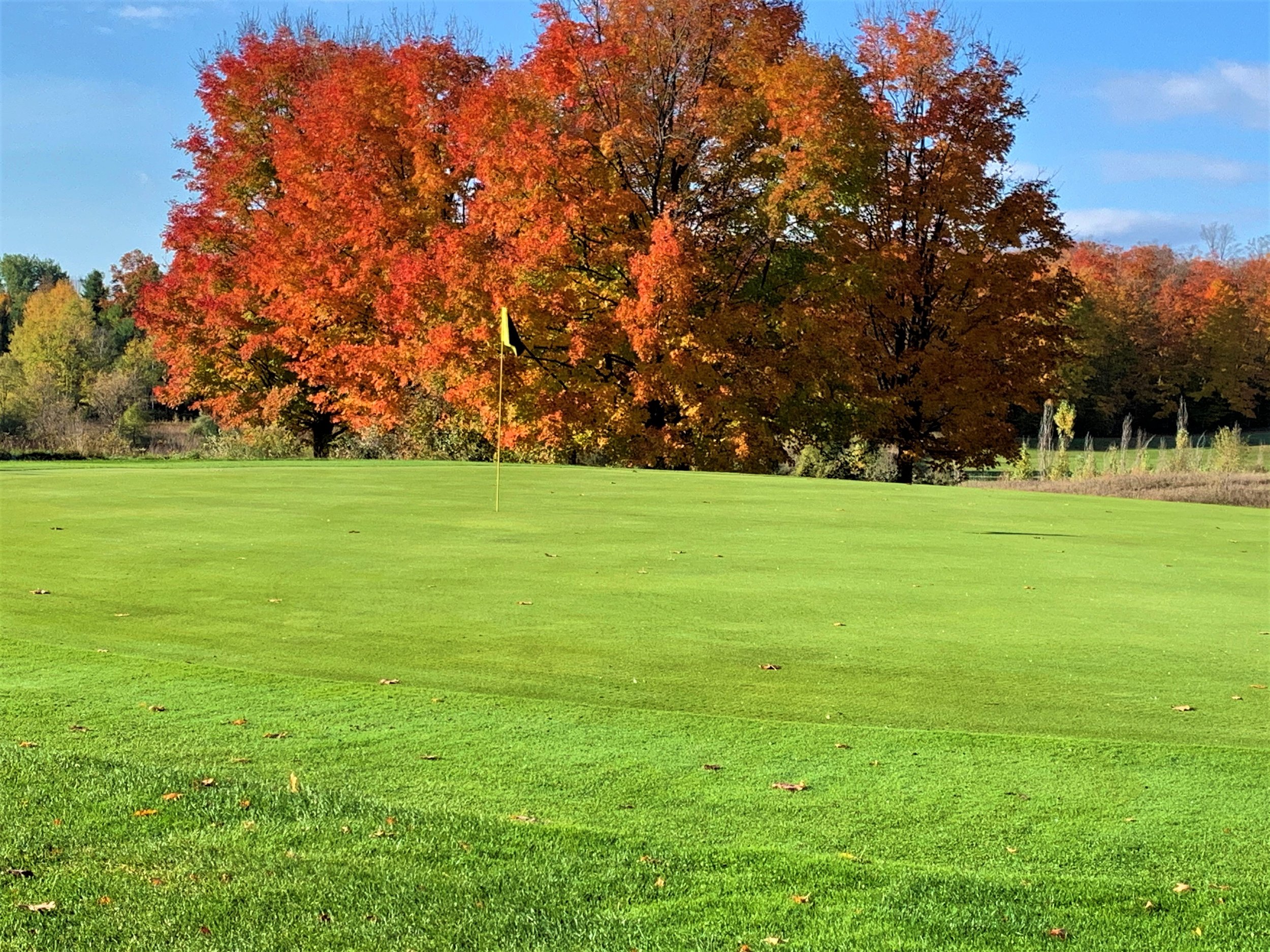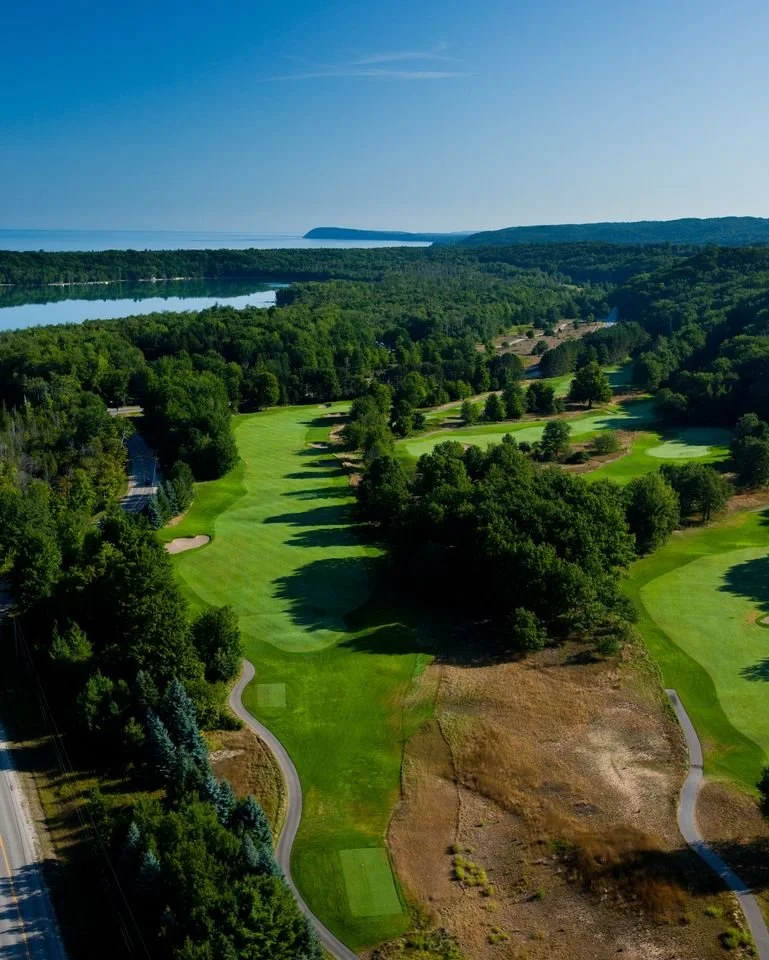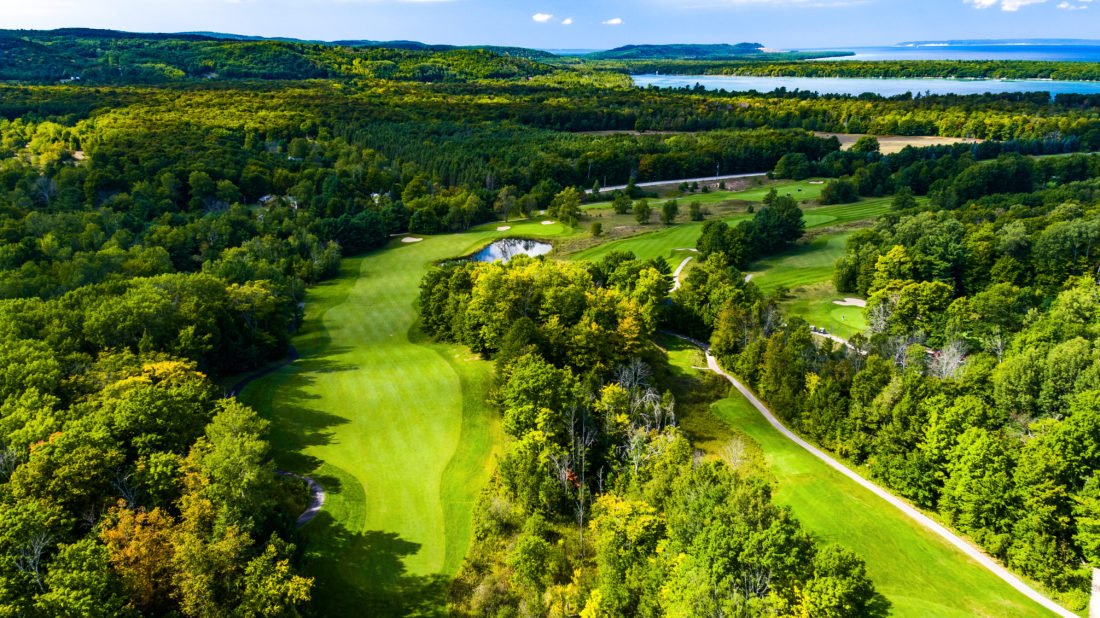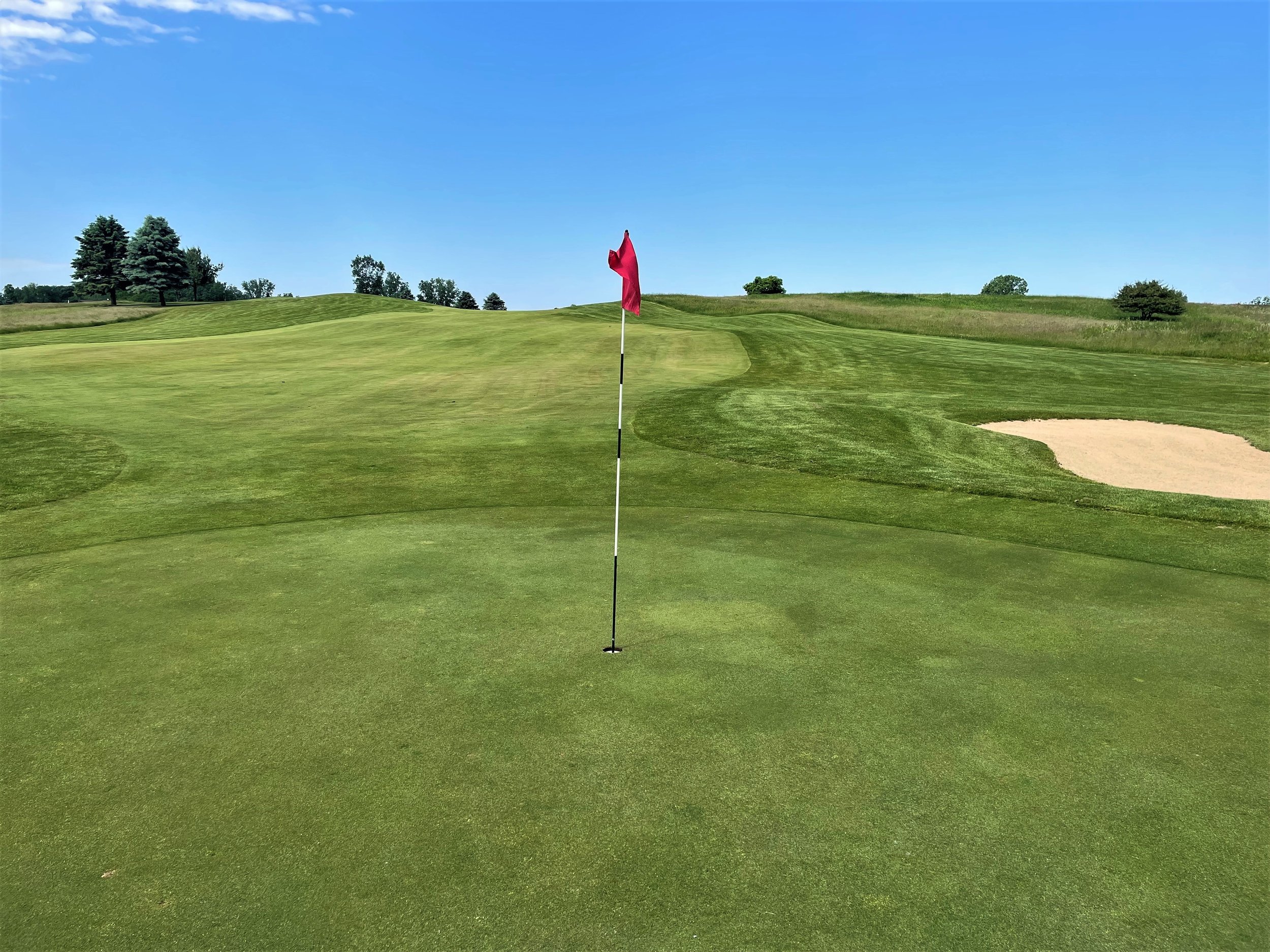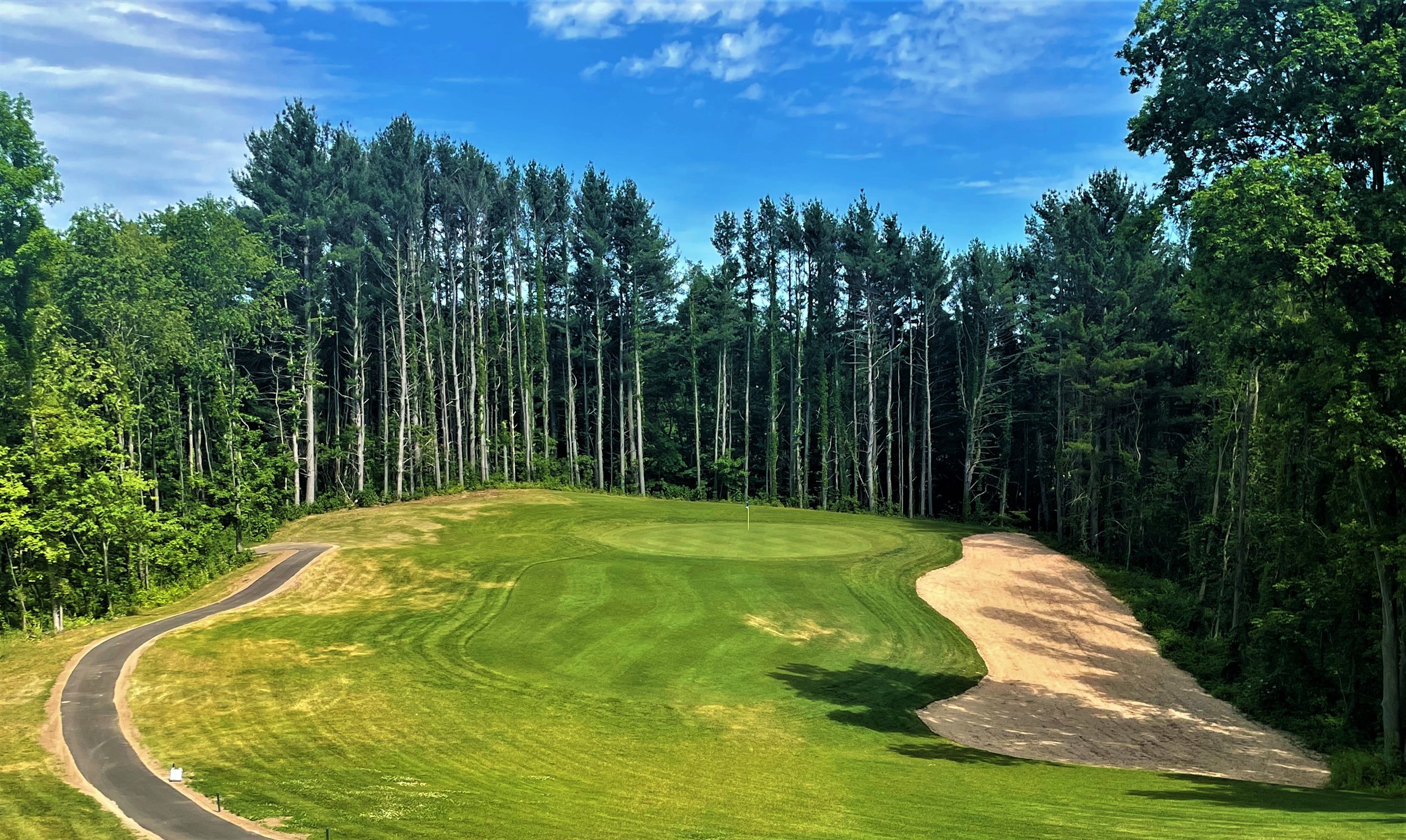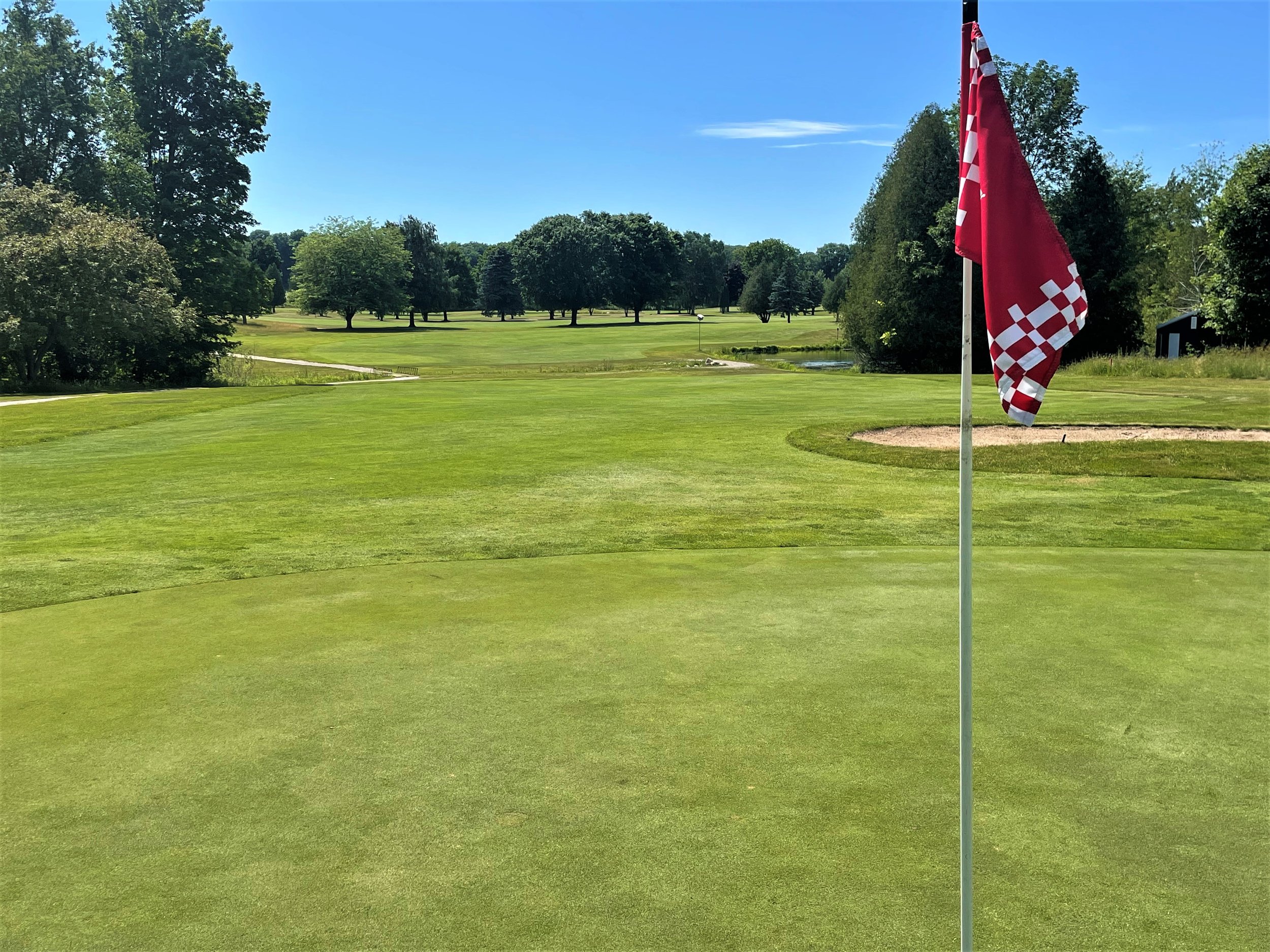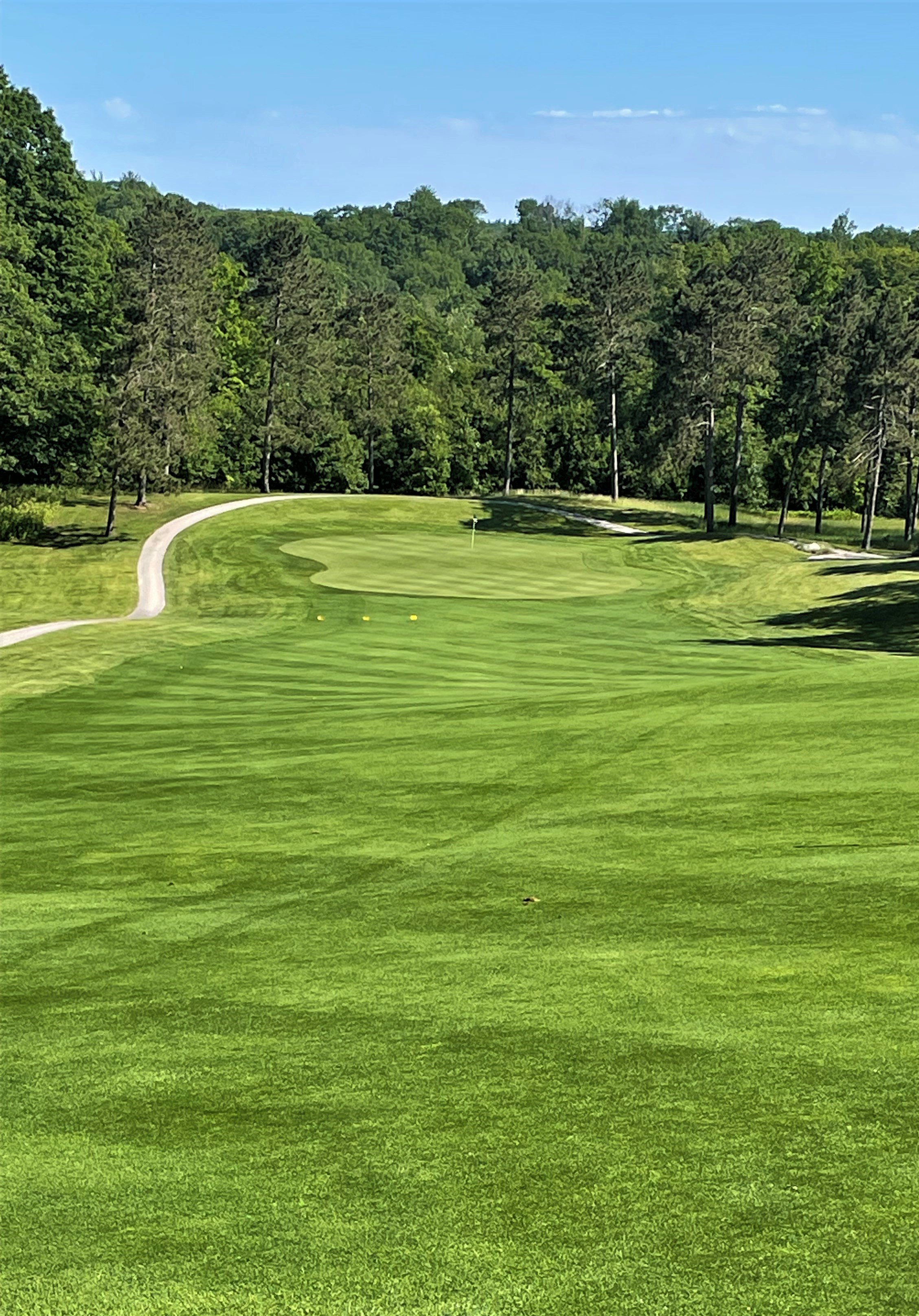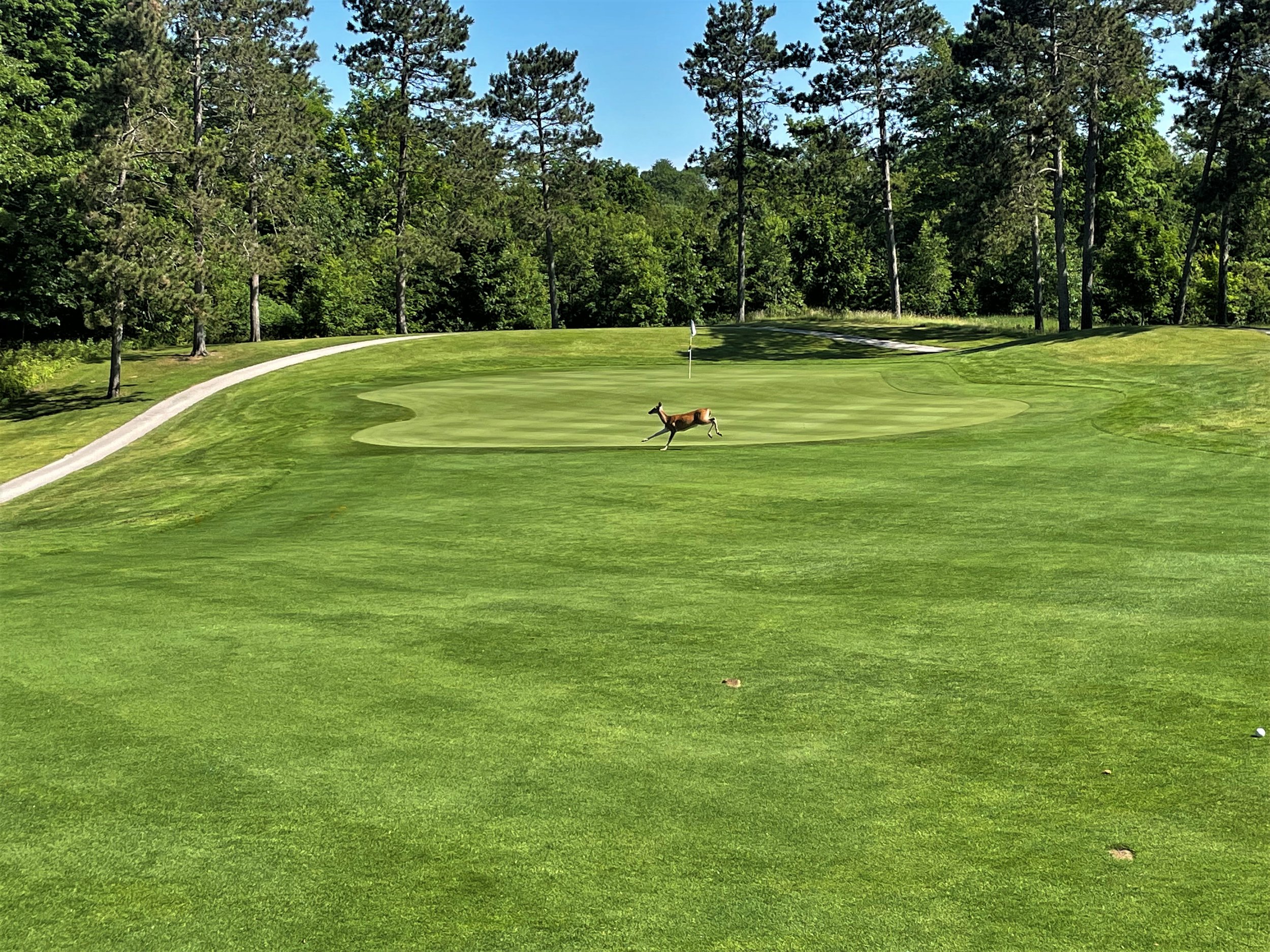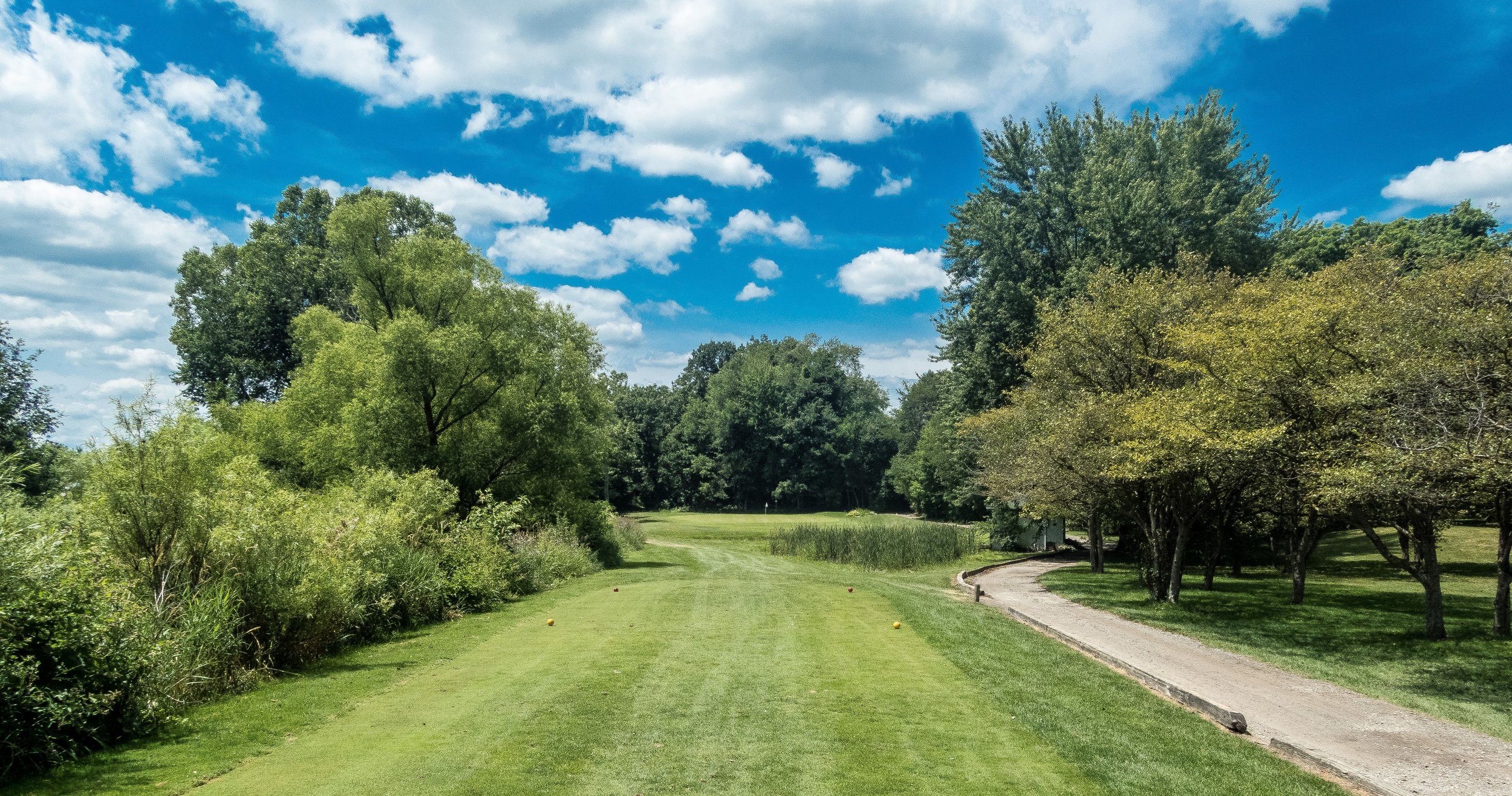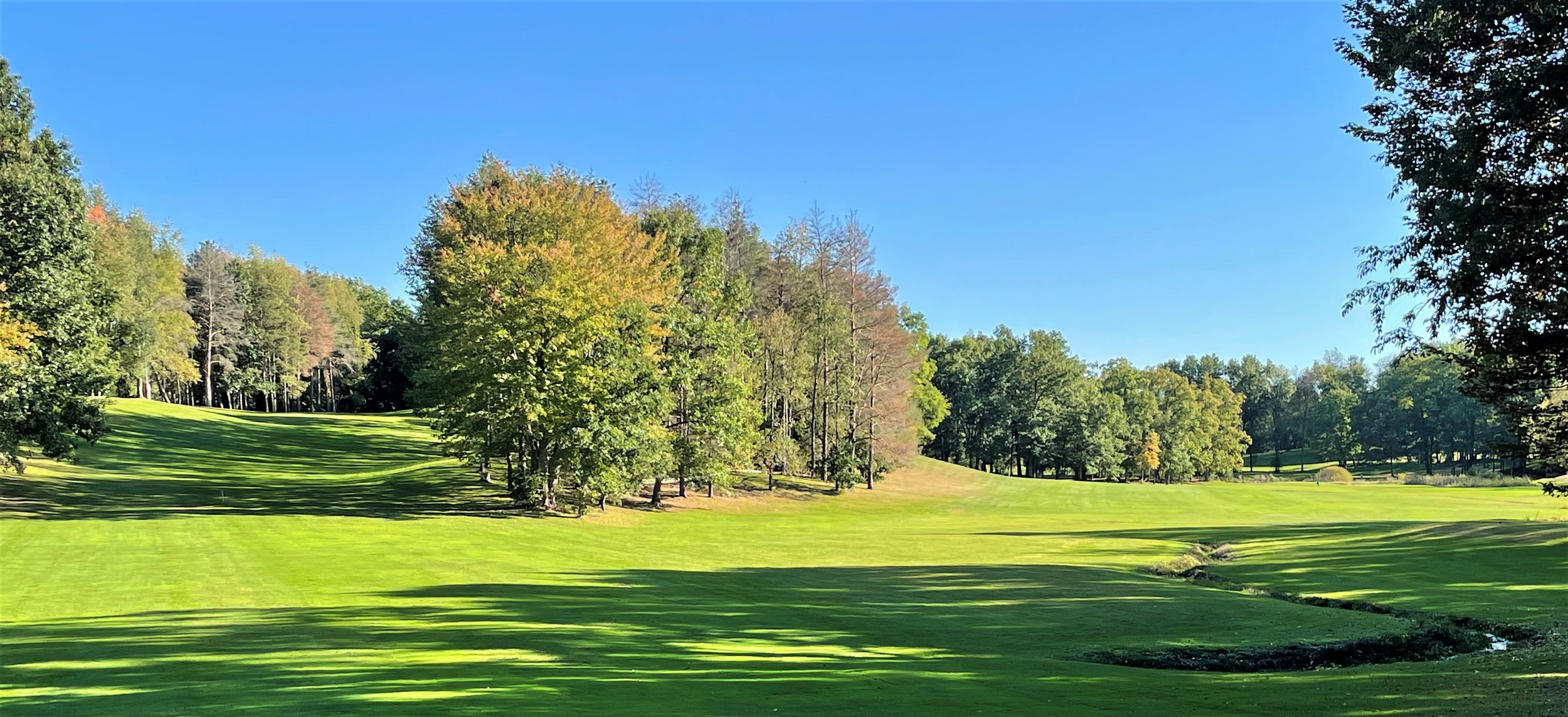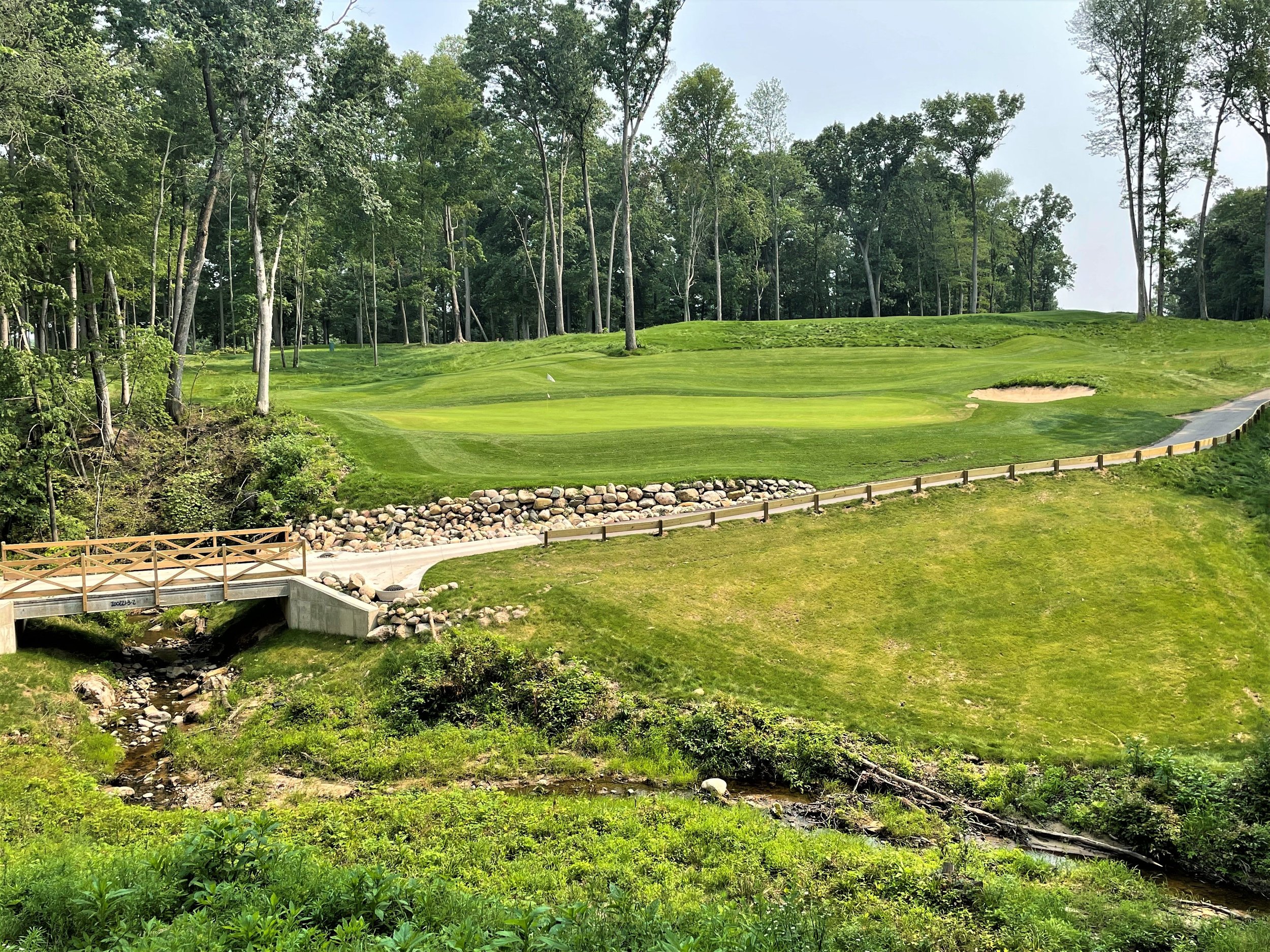Leelanau: Sugar Loaf The Old Course
By Tom Lang
If you like the challenge of aiming at smaller greens, mixed with lots of up and down terrain and wooded fairways, then The Old Course at the base of Sugar Loaf Mountain along the west edge of Leelanau Peninsula is for you.
With an average of 5,000-square-foot greens, a handful at the end of tight tree-lined fairways, this circa 1965 golf course is a shot makers challenge.
The front nine is more open and eases any golfer into their round, but it still takes concentration. No. 2 is a medium par 4 but plays longer because the green is perched high above the fairway. The green complex is made more interesting by the fact it’s a shared green with No. 5, which is located on the back addition of the green. The front nine is almost 3,300 yards from the tips, leading to the back nine that is over 3,500 yards.
“We’re not a city course. We’re out in the beautiful part of the country,” said Chris Wakeman, the GM and a mainstay at the course now enjoying his 40th anniversary on property. “Most people are used to flat, open golf courses, and you’re not going to find that here.”
Especially on the back 9.
A ravine runs through the final 9 layout, crisscrossing many holes.
No. 14 is the No. 1 handicap hole at 433 yards with a very tight fairway – which ends with a huge tree on the front right side of the green, aptly named the “Eisenhour Tree” in its resemblance to the former green obstacle on the 17th at Augusta National.
The ravine is most dramatic on the 17th hole, what used to be the longest hole in Michigan when it was first built. At 618 yards from the tips, it’s still a challenge getting to the green in regulation which is made tougher by the fact the large green (in this case) is very highly perched above the more cavernous fairway. Its landmark is a huge rock pile in the middle of the fairway that most people are hitting over on the second shot.
The closing hole is an easier par 3 framed with an old farm silo at the back of the green. A stone in the silo indicates it was erected in 1916.
Another portion of history includes the golf course’s former association with the Sugar Loaf ski resort, which shut down in 2000. More than two decades later the new owner of the former ski property just this July removed the last remnants of overnight accommodations and ski lift equipment from the property. Due to a small series of golf course name changes since the ‘60s, when people called on the phone in recent years, staff would find it easier to explain, “we’re the old course at Sugar Loaf,” which eventually stuck for the current name.
Wakeman and his staff pride themselves on great service, good conditions and affordable pricing.
“There’s a lot of new people coming, and we’ve experienced quite a bit of that the last few years, and that’s a good thing,” Wakeman said. “We do depend on our local market; they carry us through the spring and the fall. We have about a seven-week season, from mid-June to mid-August, when we start to see the exodus happen (of vacationers heading back down state).”
A perfect reason to give this course a try come fall. But don’t wait past October 31, the annual shut down date.
Leelanau: Manitou Passage Golf Club
By Tom Lang
In its early life, Manitou Passage was called King’s Challenge, an Arnold Palmer signature course cut through the woods at the base of the since-closed Sugar Loaf ski resort.
In more recent years, after a slight redesign of a couple holes, golfers still enjoy the traditional Arnold Palmer-style layout with magnificent views, tree-lined fairways and cool breezes coming off the nearby Lake Michigan shoreline.
“Obviously an Arnold Palmer design, and what that means is if you hit it to where it’s designed to, you’ll be rewarded; and if you don’t, you’re going to get punished. Yet I think it’s very fair,” said new GM Josh Schlump, formerly of Ann Arbor.
“I think it starts when you first pull in…we’re going for the wow factor,” Schlump said about the clubhouse and restaurant, the nicest building of all four courses in this series. Palmer memorabilia and his umbrella trademark abounds, from both his amateur and pro championships.
“The thing people are most surprised at when they get here is the overall layout of the golf course,” Schlump said. “We get the compliments like, ‘hey, that’s a fantastic layout,’ or ‘on No. 17 I can’t believe that elevation change,’ and the always, ‘gosh, that view from No. 8 is really cool.’
“The two nines are completely different,” he added. “Some people are a little frustrated that the turn but when we tell them it opens up on the back side, then they smile a little.”
The first hole is fairly wide open, and most golfers can reach it in regulation, but from that point forward the front 9 is fairly tight.
“On holes 2-6 you need to just hang on there and stay as close to even par as you can,” Schlump said.
No. 8 is the highlight hole of the round. It’s a long, downhill traversing par 5 that also acts as the property’s highest lookout point. The back tees are a must visit even if you are playing your round more forward – as most golfers should. Some trees were strategically removed along the tee boxes’ right side to clear a visual path to both Manitou Islands off on the distance horizon of Lake Michigan. The course is 12 miles from the shoreline, and the view at No. 8 tee gives the course its name. It’s a perfect example of hundreds of Leelanau Peninsula’s picturesque views to the west up and down the shoreline of Lake Michigan, and Grand Traverse Bay to the east.
The turn features possibly the easiest hole on the course, No. 9, then 10 is a reachable par five to kick off the back nine. Both 11 and 12 are shorter par fours to keeping easing you into the trip homeward, with additional birdie opportunities on holes 16-18.
Friday, Sept. 9 is a big day for Manitou Passage. They are hosting the First-Annual Arnold Palmer Children’s Hospital Charity Outing, to benefit the legend’s work in central Florida. Hospital reps are coming as well, to enjoy all the Michigan fall colors. You can join in by contacting the course. The event is the day before Arnold Palmer’s birthday.
Other Things To Do:
Just like all the Leelanau courses featured this month, none are all that far away from downtown Traverse City. And of the four courses, this one is closest to Sleeping Bear Dunes by a couple miles over The Old Course.
Schlump said that most families and couples use overnight accommodations at The Homestead, while buddy groups utilize Airbnb’s more often.
All-in-all, the peaceful, pristine landscape of the entire Leelanau Peninsula should be first and foremost enjoyed to the maximum. It could be the best trip you always thought about but never gave a shot – until now.
Links at Hunters Ridge is Evolving Beautifully
By Tom Lang
There’s been a lot of activity at The Links of Hunters Ridge near Howell the past few years, culminating in some excellent golf experiences for local regulars and newcomers alike.
One of the newbie’s is long-time mid-Michigan newspaper-columnist-turned-radio and TV-host Jack Ebling, who joined me for a round in early June. Now he’s threatening to become a regular.
“The Links at Hunter’s Ridge exceeded my expectations,” Ebling said. “And they were pretty high when I got there. The bottom line? I’ll be back!
“The layout was easy to follow, interesting and just tough enough. Of course, it always helps when you par the first three holes after a 10-month layoff. But reality returned soon enough (to my game.) You could tell they’d taken some extra steps to make the day fun. There was lots of TLC at The Links Course. And I’m sure the people there care about what we think. That’s not always the case.”
High Quality Design:
The Links at Hunters Ridge was designed by Jerry Matthews and Paul Albanese, the latter who was onsite almost daily for two years overseeing the construction in the mid-1990s on the Miesle family farm, dating back several generations of theirs to the 1870s. Within a few years of opening, Hunters Ridge hosted a U.S. Open qualifier.
My favorite stretch of holes on the front nine are holes 4-6. The 4th is a short par four that goes a little uphill and slightly to the right.
The 5th is a downhill par 3 requiring a good poke to clear a marsh, to a thin front-to-back, but wide green. I suggested to the assistant superintendent who joined us that day to add a sand bunker all the way across the front with a ‘beach’ style flow into the pond. It would make the carry from the tee a little less yardage but for those still coming up short they could find their ball but won’t get a free ride out of the sand either.
Then comes No. 6, a long par five that has a creek cutting across and one of the few large trees on course to navigate around.
Perhaps the crowning jewels, though, are the closing holes. The 17th tee is the highest point on the property from where you can see the entire course and drops 45-60 feet to the par three green. Then 18 is a par 5 risk-reward hole with water guarding the right side of the three-tier green complex.
The new owners the past four years have painstakingly paid attention to the details to make improvements as the course approaches 30 years of serving mostly SE Michigan golfers. Albanese has been hired again, to provide a master plan for the next decade or so.
Some new bunkers were installed to create obstacles for golf’s distance changes the past quarter century. All bunkers are full of new sand without any lips, so balls hit toward bunkers have a chance to roll right through and into green grass.
The clubhouse has been freshened up but wasn’t big enough to add a full kitchen, so the owners designed a food truck to their specs to serve all the traditional golf course fare, but assuredly some non-traditional food as well. A highlight for Ebling was the ‘Hunter Burger,’ a half-pound blend of wild board, bison, elk and wagyu beef, topped with fried onions, Swiss cheese and chipotle sauce… you know, your average golf course burger.
“My favorite part of the visit was the people,” Ebling said. “They made you feel like family. Jim (the super) and Jenny (one owner) couldn’t have been better unless Jim had traded scores with mine. And I’d never seen a food truck like that.”
Go to: www.golfhuntersridge.com for more information.
Gull Lake View Resort Invests Nearly $2M for Golfers
By Tom Lang
There is no resting on laurels for Gull Lake View Resort near Battle Creek, in Augusta.
Located halfway between Detroit and Chicago, the fourth-generation family resort, one of the largest in the country with six golf courses, won National Golf Course of the Year in 2021 for its highly-rated Stoatin Brae layout.
When some courses would sit back and simply buff the shine on such a trophy, the staff and family owners at Gull Lake View got to work to make even more improvements to carry the torch long into the future.
Where most of the renovation is most noticeable is in the 67 condos, utilized most often for family and buddies’ trips (yes, women have buddies’ trips too, which have been increasing), but the huge investment can be seen all over the multiple properties. They can sleep about 280 people per night on property.
“We spent a lot of time with the lodging,” said resort president Bill Johnson. “The buildings were first put up in the 1970s so we updated them with new beds. Three buildings got all new floors in the Villas, where we have our ‘Stay and Plays.’ We put in all new cabinets in the kitchens, and we’ve always kept updating the appliances as needed. Just trying to modernize the experience for guests.”
They’ve added all new golf carts to Gull Lake View East and West and Bedford Valley – and while the public won’t necessarily see it, lots of new equipment for the grounds crew to make their jobs easier, more efficient and making for more pleasant grounds for the golfers to enjoy. There are also plans to rebuild many cart paths this summer.
One popularity point for Gull Lake View is its location between Chicago and Detroit, and not too far from Indianapolis (3.5 hours). Johnson said being a lake region with hilly land and the closeness to large cities makes it attractive; basically 2.5 hours in either direction. “Those things really help us stay in the game.”
While Stoatin Brae gest lots of attention, as it should for its masterpiece links design on one of the highest points in Kalamazoo County, the formidable Bedford Valley continues to host important state tournaments annually, like high school state finals. It also used to host the Michigan Open, and regularly still hosts the Michigan Sr. Open.
According to Johnson, the theme is ‘big.’
“It’s a good old-fashioned golf course. There’s no tricks,” Johnson said. “It’s big. The bunkers are big, the greens are big. The trees are big. And the yardage can be big (when necessary). Bedford withstands the challenge, for all ages and genders.”
Stonehedge North has also hosted Div. 3 college tournaments as Gull Lake expands in more of those style events.
Last year the resort hit a milestone in that someone from every U.S. state (lower 48) has now been to Gull Lake View Resort. Getting Golf Course of the year in 2021 helped push some new guests to travel a long way give it a try.
“We’re getting some international play too,” Johnson said. “We have some people coming over from Scotland because they want to see Stoatin Brae (which from day one has intentionally had a Scottish feel). And every year the course matures more and more. A super fun golf course that keeps getting highly-rated. I still say the Stonehedge courses are under-rated.
“All is good at Gull Lake View.”
Sister Courses Highlight Great Golf in Oceana County
Located near very popular Silver Lake State Park
By Tom Lang
This is the 60th anniversary year for Oceana Golf Club, north up the coastline from Muskegon.
Members and locals are ecstatic to have reached that milestone, especially considering that the local public course – first designed and built by townspeople from Shelby and Hart banding together to make their own hometown course – was about to shut down after Year 57.
Its second lease on life came thanks to a local native who grew up in the area, played golf at Shelby High and eventually made it big in the financial investment services world.
Jason Wenk, 41, lifted the property out of financial stress and sure closure just months before Covid-19 temporarily shut down golf in early 2020 and he has since placed his resources into making improvements that have long-time golfers feeling giddy like a teenage girl feeling her first crush.
Multiple improvements were made two years ago during Covid’s first months; like fixing a serious draining issue on holes 1 and 9, adding new irrigation, remodeling the clubhouse and securing newer power carts.
We first brought you the historical back stories in a 3-part series in 2020.
The most noticeable changes came in late last year and are now open for play – a brand new downhill par 3 and a former drivable par 4 being combined with a nearby par 3 to create a challenging dogleg left par 4 with major risk-reward elements.
“We really looked forward to the new par 3 as they were building it,” said newer member Doug Grigonis, who drives 30+ minutes from Whitehall to play Oceana’s rebirth. “And when they changed the par 4 No. 7 (now combined to make a new Hole 8) with the big dog leg, that really improved that hole. It’s a lot more challenging now, and it’s just a great set up. The front 9 is really improved with these two changes. The whole place is coming up; and it’s nice.”
The new 5th hole is cut out of northern Michigan tall pines that form a horseshoe-shaped barrier around the back and two sides, with a waste bunker covering the right side to save wayward shots from reaching those woods. The drop off from the elevated tee is at least 75 feet, maybe more, and is 172 yards from the upper tips.
The back tees on what used to be hole 5, but is now 6, are still in their elevated location at the highest point on the property with a drop exceeding that of the par 3, to a par-5 fairway below that turns slightly right near the large green. To make up for adding a new hole, the new hard left turn dog-leg 8th hole was reconstructed as described above.
Other additions were some fountains placed in ponds to help aerate the water and help golfers see deceptively hidden water hazards.
Almost a mile-and-a-half of new asphalt cart paths were added to help preserve grass conditions.
Staff also added 15 tee boxes, to spread out the yardages more proportionally front to back and allow people to have added options to fit their games.
“We’re drawing a lot of new people from Muskegon and Whitehall, south of us 30 minutes,” said 31-year head pro Marc Inglis. “They’re willing to make that drive, because of the conditions, and the experience they’re getting here at Oceana Golf Club. The condition Corey (Parmalee) and his grounds crew keep it in is immaculate – which is all part of a capital improvement plan we’ve had going. We’ve improved and added to the equipment, and it makes night and day difference with what you can do with a golf course. It’s really paying off.”
Inglis said staff numbers have doubled since the year 2019 when the doors were almost shuttered.
The back 9 kicks off with the par five 10th hole, which traverses up and over two huge ridges and through two deep valleys to an elevated green. Holes 13 and 15 also have perched greens on the same ridge that holds up No. 10 green, with a neighboring forest as the backdrop on all three.
Benona Shores also sees rebirth:
A neighboring course less than 15 minutes away and closer to the Lake Michigan shoreline, Benona Shores, was also where Wenk played as a child. His only career hole-in-one came there on the 6th hole as a pre-teen. Combined, the two courses are very close to the famous dune rides and other summertime fun activities at Silver Lake State Park on Lake Michigan – which provides breezes almost daily on the course.
Wenk didn’t intend to purchase Benona Shores (where, as a child, he’d pay for golf at the back door of the family farmhouse still on-site), but the previously family-run par 60 course – designed mostly for summer vacationers – recently lost its patriarch leader. Combining the two courses under the same ownership made perfect sense, especially being geographically close with the ability to share resources. The personal family ties didn’t hurt either.
“The two courses, including Benona, we look at it more like we’re the steward of these places, not the owners,” Wenk said. “This is a time in which we have the responsibility to take care of these places and make sure they’re here for a long, long time.
“The course has always been phenomenal. The land is just really special. The biggest mistake we could have made there was messing it up (the course).”
Nothing looked messed up to me – just primed for great community golf and a better-than-normal recreational opportunity for summertime visitors to the region. I played it in late June and had a glorious time. Unfortunately, many people see par 60 and rebuff it as a ‘par 3 executive’ course. That couldn’t be further from the truth.
Benona Shores is a tough track, but without any par fives makes it more enjoyable for a wide range of golfers; those people learning the game, while it remains challenging for those more experienced.
I enjoyed most the starting holes on both nines. Hole 1 strikingly goes up hill to the halfway point, then all downhill to the nicely shaped two-tier green. That par 4 is followed by two par 3s that each traverse uphill, followed by strikingly downhill par 4 that sharply turns right at the elbow. All four are tree lined, before getting into a more open part of the course that’s flooded with apple, pear and apricot trees away from the fairways that were left standing from the former orchard the course is carved into. Holes 10 and 11 are us tough and attractive as any par 3-par-4 holes.
It’s clear why Wenk said the course was top-notch already – his investments are almost all to buildings and equipment. The clubhouse has been renovated and is to be expanded; the parking lot is no longer just a beat-up grassy patch, as new landscaping features greet arrivals, and brand-new power carts with super-plush seats await us for traveling the undulations of the land.
Local golf courses mean so much to thousands of people across the state – as gathering places in open green spaces, recreation for good health and well-being, charitable and economic support in the community, socializing with friends, and making new ones.
All of the above and more are why small-town golf courses are critical to communities, and these two sister courses are getting the job done in style.
Freeways and Fairways: Wheatfield Valley Golf Course
By John Retzer (GolfBlogger.com)
Editor’s Note: this is one in a long series of examining golf courses located along Michigan freeways that you might drive by often but haven’t yet stopped in to try.
Wheatfield Valley falls into the category of “pleasant small-town courses,” the likes of which you can find in literally hundreds of hamlets across the Mitten State. In this case, the town is Williamston, located about 20 miles east of Lansing.
The course is aptly named, for it was built on former farmers’ fields. In fact, I’ll coin a term here: Along with linksland, parklands, and woodlands courses, there is a distinct species called “farmlands.” There are a lot of those in Michigan. It’s not a derogatory term, though, any more than it is to note that The Old Course was once a sheep pasture.
As a farmlands course, Wheatfield Valley is mostly open, and mostly flat, with light woods on its perimeter that in its agricultural heyday might have served as windbreaks or boundary lines.
The “Valley” is a low area on the back left (southeast) end of the property, abutting I-96. Half the course’s holes are routed through those lowlands, with four (Holes 2, 8, 13 and 16) taking advantage of the one-to-one-and-a-half club elevation change.
Wheatfield Valley is a relatively short par 70. From the tips, it measures just 5,726 yards, with a slope of 117 and a rating of 67. In truth, it’s more like a par 69, because the par 4 eighteenth tips out at just 201 yards. The longest hole is the 506-yard par 5 17th.
Struggling putters will love Wheatfield Valley’s greens, because they are mostly flat. Short hitters will also love this course. If you’re a long hitter, think of Wheatfield Valley as an opportunity to practice hybrids and irons off the tee.
My favorite hole at Wheatfield Valley was the downhill, dogleg right par 4 13th. Measuring 360 from the back tees, the 13th starts from an elevated tee. A good shot is straight out to the left side of the fairway, playing wide of the trees on the right. There’s a bunker out there to threaten a shot that carries too far, so pick your distance carefully. The second shot is into a relatively deep and flat green. Land your shot on the front and let it carry to the hole.
No one will ever mistake Wheatfield Valley for a country club, but for a neighborhood course it was adequate. Michiganders are lucky to have so many course operators bringing golf to every corner of the Mitten State.
Freeways and Fairways: Pine Hollow
This review is part of an occasional series that looks at golf courses found along Michigan freeways – those you drive by frequently, or on that annual vacation, but never seem to have time to stop and explore. Here is my assessment:
By Tom Lang
A cozy little out of the way 18-hole golf course that’s not so out of the way as it lines I-94 westbound near the Sargent Road exit east of Jackson: Pine Hollow Golf Club.
It’s not going to host a national or state tournament, but for less than $30 for a cart and round of golf, it can be a nice place for newcomers to try golf and old timers to hang out with their buddies as all come to play the game they love.
There is not a sand bunker to be found on the course and the greens are not tricky or filled with undulations – all good things for beginners and intermediate players trying to improve their games. But when there is no sand or other hazards missing, it’s a guarantee every course will throw some other challenge at golfers. In this case it’s trees, and some with large over-hanging limbs.
A few holes are wide open off the tee, but very few. The 18th is the most spacious, so if you’ been waiting all day to let it rip, that’s the hole to do so – a par 5 and you’re all warmed up by then. A good improvement to the enjoyment of playing at Pine Hollow would be an aggressive tree trimming program by ownership soon; not necessarily tree cutting, but serious tree trimming.
In online surveys the course gets a 4.1 out of 5 rating. I agree with the reviewers that it’s fun and attractive with its rolling landscape, and it’s not overly crowded. But I also agree with one reviewer that said the fairways need to be mowed more often – yet, in a weird way they still seemed to roll out pretty well under the early autumn conditions.
The back 9 has more character than the front (which borders the freeway) in its routing and land features. No. 15 is a beautiful long downhill par 4 lined with pines, and 17 is a drivable par 4 downhill if you keep the ball way to the right and let the steep slope take your ball toward the large green. And remember, when you get to 18 tee, let it rip.
Freeways and Fairways: Emerald Golf Course
By Tom Lang
The season is winding down on 25 years of The Emerald, situated along U.S. 27 to the north of St. Johns. Right across the highway is a long-time family staple for trips up north, the Uncle John’s Cider Mill.
Playability: For several years the course previously hosted high school state finals, so it sports a good combination of challenges from select tee boxes, yet Emerald remains a course that won’t bury junior golfers and others new to the game. For those who like to know which club to pull out of the bag (and all will be tested), multiple markers made of tall native grass bushes placed 100-150-200-250 yards from the green, plus sprinkler head measurements to center of green, helps everyone.
Yards: 6619 from tips, 5031 from forward tees.
Hole to Remember: No. 17 (451 yards from back tee) is one of those reachable par fives that can call out your name and whispers into golfers’ ears, “go for it.” But the approach can be tricky due to a stream that tightens the fairway near the green, making it a great risk/reward hole for those big hitters going for it in two to the elevated green. Balancing out a hole like 17 on the other side of the course is No. 4, a tough par 3 with water on the right and OB to the left; 223 yards from the tips. Many holes in between are a lot of fun, too.
Value for the money: Considering the experience of rolling terrain mixed with five ponds and many hardwood tree-lined fairways, rates are very fair at mid-Michigan’s “gem.”
Why try it:
Women friendly award as a top 100 course in the nation by Golf for Women magazine several years ago.
Known for very fast greens if that’s what you’re looking for.
The main comments inside the clubhouse of new golfers is: “I’ve driven by for years and always wanted to stop and try it.” Do it.
Web site: www.emeraldgolfcourse.com
A New 9 at Saskatoon Golf Club
By Tom Lang
The already bustling Saskatoon Golf Club near Caledonia opened a new 9 holes in mid-June called the Silver Course that’s drawing more attention than the club thought it would.
That’s understandable, because it’s an excellent layout that adds new features on the property that already had four sets of 9-hole courses and is a popular home for league play that alone accounts for more than 1,300 golfers each week all summer. The Howard family has had to allow play only four days a week in the beginning to give the new and still tender grass on the Silver time to recuperate from the traffic.
The first hole is a very attractive par 4, with a sand trap left and a stand of trees sticking out from the right at a distance where many drives land. On the tee you can see the green trying to peek through those same trees, where all the lower branches are trimmed, and ground brush is gone for golfers to retrieve and hit balls out from trouble more easily.
The second hole is a blind tee shot starting the long par 5. The 4th and 5th holes are separated by several dozen tall White Pines framing both holes, providing a distinct “Up North” vibe. All the fairways have some variation of rolling terrain sure to provide some side-hill lies.
I would call the 6th the signature hole, a par 3 crossing back over the same creek golfers had to carry off No. 4 tee. The green on 6 is lower than the tee boxes and backs up to Hole 2 that sits high atop the hill separating each green, creating a bowl effect on No. 6. The 8th hole is a long downhill par 3, giving the course a par 35 overall.
Two tall, mature Maple trees really caught my eye. The first is near the right dogleg bend of hole 5, about 60 yards back from the middle of the green and almost middle of the fairway. The second Maple sits at the right front edge of No. 9 green. Both have all the limbs of the lower half trimmed off so golfers can go under the leaves canopy with their approach shots, but slightly off shots could smack right into the thick trunk. Yet like Lee Trevino likes to say, “aim right at the tree trunk and you’re sure to miss it.” That said, they are a little imposing, but will seem very cool come fall color changes.
The new Silver Course sits near the Gold Course (est. 1992) on the north side of the road that splits the property. They will be bundled as one 18 course and the current Blue and White Courses will be bundled as a second 18. The original Red Course will be used mostly for a stand-alone 9 that’s popular with the older crowd and beginners but can be added to any mix. A huge newer open-air pavilion can seat 200 people for outings and weddings.
More info at: https://www.saskatoongolf.com/


